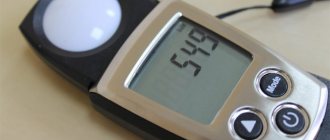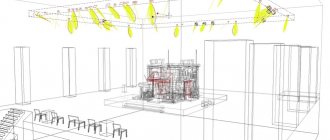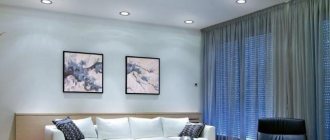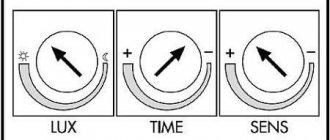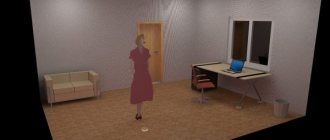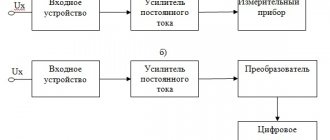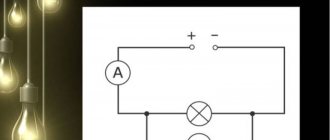Precision is paramount | 12/26/2016
A lux meter is apparently some kind of measuring device. But not everyone will give a clear answer as to what quantity he controls. It’s good if they remember about the lighting in the room or workplace. Indeed, the device is designed to measure one of the characteristics of the lighting environment. We will try to cover this issue in detail: the purpose, principle of operation of the device and methods of its use.
A little theory
There is a lot of confusion on the Internet in scientific and technical terms related to the field of lighting technology. The same device is called differently. The device in question, a lux meter, for example, is sometimes passed off as a luminous flux meter, although it is not.
Luminous flux is a characteristic of a lighting element, and we can talk about this value only in relation to a specific lighting source (incandescent lamp, gas-discharge element, LED, etc.). The SI unit of this characteristic is lumen (lm). This is the luminous intensity of 1 candela (cd) per solid angle of 1 steradian (sr).
This parameter is measured using a photometric ball (spherical integrator) with a diameter of 1 or 2 meters, or with desktop integrating spheres ranging in size from 10 cm to half a meter. All these devices, naturally, are not for household use, since the price of even a small domestic device TKA-KK1 for monitoring LEDs is 35,000 rubles.
The flux of light acting per unit area is expressed by illumination. The unit of this characteristic is lux (lux) - the result of illuminating a surface of 1 m² with a flux equal to 1 lumen. The concept of “illuminance” does not refer to the light source, but to the environment. The luminous flux is a constant value for each source, while the illumination at each point in the room depends on several factors:
- the number of sources located near the measurement site;
- light pressure of each of them;
- distances to sources;
- reflective ability of furnishings.
Types of lighting
4 types of artificial lighting are used:
- General (with this lighting, a uniform distribution of the light flux is produced over the entire area of the room. It is achieved by uniformly dispersing light sources over the entire area while maintaining the distance between them);
- Local (used for improved lighting of a separate work area);
- Combined (includes general and local lighting);
- Emergency (rarely used. Designed to provide lighting when the main light source is turned off).
What is a lux meter and what is it for?
“Measure everything that can be measured, and what cannot be measured, make it measurable” - this aphorism attributed to Galileo confirms that illumination can also be measured. Since its unit is lux (in Greek - light), the device for measuring illumination is called a luxmeter (meter - I measure). It is used both indoors and outdoors. In what cases is it used?
It has been established that both weak and excessively bright light has an adverse effect on processes occurring in the brain. With a lack of lighting, performance decreases, concentration decreases, and drowsiness occurs. Excessively bright light leads to stimulation of the nervous system. Both of these create the preconditions for an accident. Therefore, planned labor safety measures at workplaces include checking the lighting of workplaces. GOST R 55710-2013 sets standards for illumination (in lux) of premises for various purposes. To put it simply, in an office, according to sanitary norms and regulations (SNIP), the illumination should be from 200 to 300 lux.
The process of photosynthesis in plants, which produces nutrients from carbon in the air, occurs under the influence of light. At the same time, plants react differently to temperature conditions and light levels. Almost all cultivated plants and most vegetables develop well in moderate lighting conditions. Other species require high temperatures and light. Therefore, lux meters are used to control and maintain the required illumination for various crops in greenhouses, greenhouses, and botanical gardens.
Artificial lighting
At night, illumination is produced artificially - with all kinds of electric lamps.
Artificial lighting can also be used in the daytime with weak daylight, as well as in buildings where it is technologically impossible to have the appropriate number of windows, for example, the ground floors of buildings or basements.
The state of the atmosphere and geographical location are also taken into account.
Design and principle of operation
The basis of any lux meter is a photocell - a semiconductor device in which light quanta transfer their energy to electrons, resulting in an electric current. The current strength is proportional to the amount of illumination in the place where the photodetector is located.
Another element of the lux meter is an analog or digital indicator. In mechanical devices, an electric current converted by a galvanometer causes a rotational movement of the pointer needle. In digital devices, an analog signal (electric current) is converted into a digital signal using an optical-electronic converter, with the result displayed on a liquid crystal display. Structurally, both units (photodetector and converter) are made either in the form of independent elements connected to each other by wire, or in a common housing.
A monoblock is better suited for quick measurements because it weighs less and is more convenient to use. However, inconveniences arise when measuring in hard-to-reach places, from different directions and recording readings. Therefore, when conducting workplace certification, devices with a remote photosensor are most often used. Let's look at some of the most common models.
Types of lamps for room lighting
Artificial illumination is achieved through the use of electric lamps, which convert electricity into light flux.
At one time, incandescent lamps were the most common. The wide power range of these lamps made it possible to select a light source with the luminous flux required for certain conditions.
Recently, they have become less in demand because they are economically expensive.
The second type of lamps used for lighting is fluorescent.
Device for measuring illumination Yu-116
The device is still a Soviet development Yu-116 in the range from 1 to 100,000 lux. It consists of 2 parts: a selenium photocell and a pointer galvanometer, which is used to measure readings. Stored in a case unassembled, which provides reliable protection from damage. Before operation, the photodetector is connected to the converter using a plug.
The meter scale has 2 concentric arc scales. The inner one is graduated from 0 to 30 lux, the outer one - from 0 to 100. The photocell is equipped with a light-scattering attachment consisting of white translucent plastic and an opaque ring. It is designated by the letter “K”, measurements with it are made in the above ranges. There are 3 more filter attachments: M, P and T. When installed in parallel with the base attachment K, the measurement range increases respectively: 10, 100 and 1000 times.
Two buttons on the instrument panel are designed to switch from one scale to another. When the left button is turned on, measurements are made in the ranges: 0 – 30, 0 – 300, 0 – 3000, 0 – 30,000 (when installing the appropriate attachments). When the right one is on: 0 – 100, 0 – 1,000, 0 – 10,000, 0 – 100,000. In addition to the buttons on the case, there is a corrector for setting the dial indicator to the zero position.
The Yu-117 light meter differs from its predecessor only in the large number of buttons. Instead of two scale switching keys, the device is equipped with five range switching buttons, which increases the measurement accuracy. Buttons for turning on the device, power control and a zero control knob have also been added. Both models are powered autonomously - from a galvanic element of the Krona type with a voltage of 9 V. The price of devices from different sellers is from 6 to 10 thousand rubles.
Criterias of choice
To choose the optimal photometer model, consider the following parameters:
- Functionality;
- Type of device (professional, household);
- Range of measured illumination indicators;
- Measurement accuracy level and error;
- Size of the device (it is more convenient to work if the meter fits in one hand);
- PC compatible;
- Display size and backlighting;
- Cost of the device;
- Availability of verification.
If a lux meter is needed for quick measurements, an inexpensive monoblock with a small set of functions is suitable. For professional work, you need a multifunctional device with built-in memory, a removable sensor, minimal error and verification.
If the lighting level complies with current standards, work and study will be more comfortable. However, not all organizations comply with the established rules. As a result, people experience vision problems and decreased performance. A lux meter helps prevent this.
Based on the data obtained as a result of measurements, new light sources are installed or existing lamps are correctly positioned. The criteria discussed in the article will help you choose the right light meter.
How to use a lux meter?
You can quickly and safely find the desired measurement range for a photodetector if you act in a certain sequence:
- Install attachments with maximum light absorption (K and T) on the photodetector, turn on the right button, which corresponds to measuring the maximum illumination - 100,000 lux. If the measuring needle does not respond, turn on the left one (up to 30,000 lux).
- If the arrow does not move, replace the filter with a more transparent one (P) and turn it on in the same sequence: first the right button, then the left one.
- If there is no movement, install a soft filter (M) and perform similar manipulations.
- If in this case, when the left button is pressed, the result is less than 5 lux, remove the base attachment K and end the search.
To move the measured value away from the area of overlap of the two scales (in the region of 5–20 divisions), it is recommended to start counting the measurement from 5 divisions on the inner scale, or from 20 on the outer scale. For this purpose, reference points are marked on the scales.
Remember: excessive illumination of the selenium photosensor may affect the accuracy of the measurements, so follow the given sequence of actions.
Equipment under test
Our experiment involved iPhones of different series, as well as Sony, Samsung and Nokia phones:
| Manufacturer | operating system |
| iPhone5 | iOS |
| iPhone 5S | iOS |
| iPhone 6 | iOS |
| Sony Xperia Z1 | Android |
| Sony Xperia Z2 | Android |
| Samsung Galaxy S5 | Android |
| Nokia Lumia 925 | Windows Phone |
Will the results be the same on similar smartphones with the same applications?
To test this, we used 4 identical iPhone 5s with the "Galactica Luxmeter" and "LightMeter by whitegoods" apps installed on them. Unfortunately, we were disappointed. All four smartphones showed completely different performance.
We believe that the reason for such fluctuations is the difference in components in the phones. The user does not notice such deviations during everyday use, but during direct testing they are noticeable.
Software
We selected the following applications (most of them are free) and installed them on each of the systems:
| Name | Manufacturer | operating system | Calibration capability | Price |
| Galactica Luxmeter | Flint Soft Ltd. | iOS | No | — |
| LightMeter by whitegoods | Whitegoods | iOS | There is | — |
| LuxMeterPro Advanced | AM PowerSoftware | iOS | There is | 7,99€ |
| Luxmeter | KHTSXR | Android | There is | — |
| Light Meter Pro | Mannoun.Net | Android | There is | — |
| Lux Light Meter | Geogreenapps | Android | There is | — |
| Sensor List | Ryder Donahue | Windows Phone | There is | — |
For reference
The control measurement was carried out using a calibrated PRC Krochmann lux meter (Model 106e, special model, class A).
